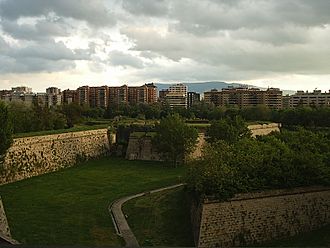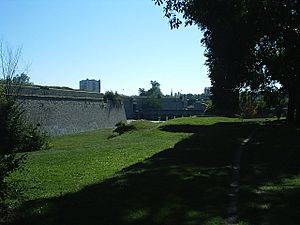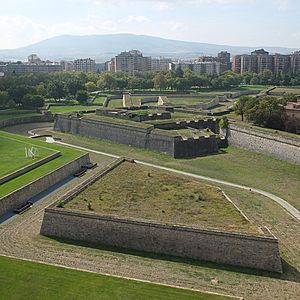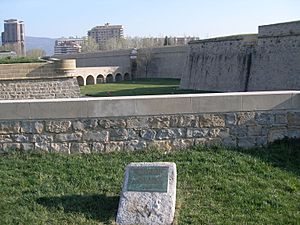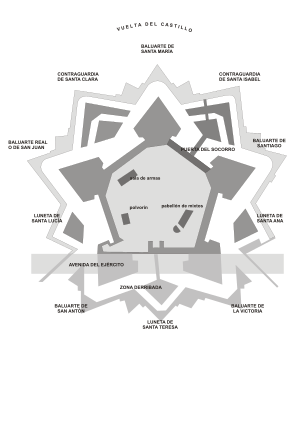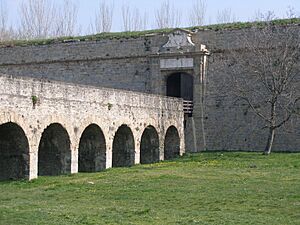Citadel of Pamplona facts for kids
The Citadel of Pamplona or The New Castle is an old military fort. It was built between the 16th and 17th centuries. You can find it in Pamplona, the capital of Navarre, Spain.
Today, most of the fort is a public park. Its old buildings are used for fun cultural activities. In 2015, UNESCO recognized the Citadel as part of the important Camino de Santiago route.
Building the Citadel
King Philip II of Spain ordered the Citadel to be built in 1571. He wanted to make the city walls stronger. The main engineer was Giacomo Palearo, also known as "el Fratin." Vespasiano Gonzaga y Colonna, the viceroy of Navarre, also helped.
They designed the fort like a five-pointed star. This shape was very modern for its time, similar to a fort in Antwerp. Each point of the star helped control different areas. Two points faced the city itself. This helped to keep control of Pamplona, especially after the Kingdom of Navarre was conquered. The Citadel was meant to protect the city from outside dangers and also to keep peace inside.
The different parts of the star-shaped fort are called bastions. Their names are San Antón, el Real, Santa María, Santiago, and Victoria.
The main building work finished in 1645. Later, in the late 1600s and early 1700s, more defenses were added. These included "half moons," which are extra protective walls. These additions followed a design system by a famous military engineer named Sébastien Le Prestre de Vauban.
The Citadel's History
The Citadel of Pamplona has not faced many big attacks. However, it has been taken over a few times.
In 1808, Napoleon's French army, led by General D’Armagnac, took the city. They used a clever trick. On a snowy day, French soldiers pretended to have a snowball fight near the fort. They had hidden weapons under their clothes. When they got close enough, they quickly took over the city. Similar tricks were used by Napoleon's troops to capture other forts in Spain.
Later, in 1823, liberal soldiers held out in the Citadel for five months. They were fighting against an army called the Hundred Thousand Sons of Saint Louis. This army wanted to bring back absolute monarchy. The Citadel was bombed heavily. After a long fight, the soldiers inside surrendered on September 16.
During the Spanish Civil War, a sad event happened at the Socorro Gate of the Citadel. Many people who supported the Republic were killed there. In 2007, a plaque was placed to remember them. In 2012, a stone monument, called a monolith, replaced the plaque.
The monument's message, in Spanish and Basque, honors the 298 people from Pamplona. It says they were killed in 1936 for "defending freedom and social justice."
The Citadel Today
In 1964, the military stopped using the Citadel. It was then turned into a popular public park. The old military buildings inside the park are now used for cultural events.
Some of these historic buildings still stand. They include:
- The ammunition dump, built in 1694.
- The warehouse for mixed goods, updated in 1720.
- The artillery room, designed in 1725 by engineer Jorge Próspero Verboom. He also designed the Citadel of Barcelona.
The park is now in the center of Pamplona. It is surrounded by another large green area called Vuelta del Castillo. This area has always been a park and has no military buildings.
Together, the Citadel park and the surrounding green spaces cover a huge area of about 275,840 square meters. In 1971, people were asked what they wanted for this area. Most agreed it should stay a green space with historic buildings. They wanted to avoid new construction there.
In 1972, the city council decided to keep the old artillery building where it was. The next year, the military park was officially declared a "Natural Historic-Artistic Monument."
The Citadel was designed as a perfect five-pointed star. However, in the late 1800s and early 1900s, two of its strongholds were partly taken down. This allowed the city to expand and build new houses and streets. For example, the Avenida del Ejército was built in 1971.
Today, the House of Congress and the Auditorium of Navarre stand on the remains of one stronghold. In 2007, a new bus station was built underground next to the Citadel.
See also
 In Spanish: Ciudadela de Pamplona para niños
In Spanish: Ciudadela de Pamplona para niños


